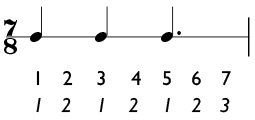In a music score the time signature appears at the beginning as a time symbol or stacked numerals such as or 3 4 immediately following the key signature. As you saw in the time signature examples above each time signature has two numbers.

Time Signature Music Appreciation 1
A curved line placed at the end of a stem.

. This above melody is written in 128. A recurring pattern of accents that occur over time. 34 time certainly isnt quite as common as 44 but its still a fairly popular time signature.
A time signature of 42 contains four half notes in each bar and 48 contains four eighth notes quavers in each bar. There are three main beats in the bar and therefore this time signature would be considered a compound triple time signature. If a time change occurs later in a song it will show the break and the new meter.
Pages 54 This preview shows page 11 - 15 out of 54 pages. Song with one time signature throughout. Rhythm in music is characterized by a repeating sequence of stressed and unstressed beats often called strong and weak and divided into bars organized by time signature and tempo indications.
Each section of music has a meter that is defined by the time signature. Meters are notated with a time signature. The bottom number of the time signature indicates a certain kind.
Music that uses 68 tends to have a more jaunty or dance-like lilt or can have a rolling feel. Multiple voice parts 6. Now up your study game with Learn mode.
May include a stem beam andor flag. The time signature is a notational convention used in Western musical notation to specify how many beats are contained in each measure and which note value is equivalent to a beat. In 68 we also feel the pulse once per quarter note but the beats subdivide the pulses into three eighth notes.
The term odd meter however is sometimes used to describe time signatures in which the upper number is simply odd rather than even including 34 and 98. Unit of measurement of 1 rhythmic pulse of music. Triple meter also known as triple time is a.
It shows us whether the beats are eighth notes quarter notes half notes or another note value. The number of notes allowed in each measure is determined by the time signature. And the top number describes how many of those beats are in each measure.
Common examples of compound time signatures are 68 128 and 94. Course Title MUSC 107. A meter with two beats each of which divides into two.
Three quavers in a dotted crotchet. A song style in which verses are sung to the same tune with a repeating chorus in between a folk music b polyphonic c. The time signature shows that the meter is in two.
There are two beats in every measure. 68 time a type of compound duple meter is popular among songwriters and is certainly the most common compound time signature in music. Music that uses 24 instead of 68 tends to have a more straight or march-type feel.
When the pulse consists of eighth note beats the bottom number of the time signature is 8. A mid-score time signature usually. Which statement best describes mixed meter.
You just studied 12 terms. Meter and Time Signature. 68 would considered a compound duple and 98 would be considered a compound triple meter because it has three strong pulses.
The grouping in which a succession of rhythmic pulses or beats is organized indicated by a meter time signature at the beginning of a work. Includes both a pitch and rhythmic component. Two beats per bar is called duple meter three beats triple meter four quadruple meter and so on.
Pts question 18 this meter signature best describes. 24 time 34 time 44 time 38 time 98 time 42 time 31 time and so on. Three quavers within every strong beat a dotted crotchet.
The bottom number tells us what those beats are worth. 68 is a commonly interpreted time. The duration of silences in music.
68 Time What songs are in 68 time. Music of urban society often written down and developed primarily for entertainment 7. You wont have to look too far to find a song you like in.
An irregular time signature is one that cannot be divided into equal groups of notes for example 54 or 78. The most commonly used compound time signature is 68 which has two strong pulses divided by three beats each. In compound time signatures the beat is broken down into three-part rhythms creating a one-two-three pulse.
Compound meter. As opposed to the key signature which is repeated on every line on music the time signature is only given once at the. Compound time signatures show the number of sub division in the top of a time signature.
Although these more complex meters were and are common in some non- Western music they were rarely used in formal written Western music until the 19th century. The time signature shows us the relationship between the number of beats in a measure and the type of beat that is used. The lower number of the time signature denotes the note value in each measure or bar.
The most common time signatures for simple quintuple meter are and and compound quintuple meter is most often written in. A top number and a bottom number. Each beat in this time signature also divides into three.
Both 34 and 68 contain six eighth notes but it is understood that a 34 bar contains three quarter note beats whereas a 68 bar contains two dotted quarter note beats.

Time Signatures Meters Everything You Need To Know School Of Composition

Understanding Time Signatures And Meters A Musical Guide

Time Signatures Music Theory Academy What Is A Time Signature
0 Comments